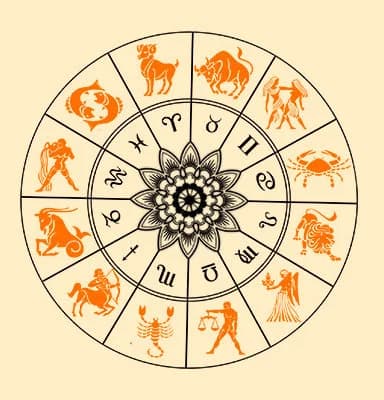What is a Nakshatra?
A Nakshatra is a term used in Indian astrology that’s made up of two words – “Naksha,” which means a map, and “Tara,” which means a star. So, when you put them together, it basically means “Mapping of the stars.” You can find its references back to ancient texts like the Rig Veda, Yajur Veda, and Atharva Veda.
The meaning of Nakshatra is quite clear in Indian astrology. It refers to groups of stars or constellations that have an impact on a person’s life from the moment they are born, depending on where the moon is situated. In total, there are 27 Nakshatras. The names of these 27 Nakshatras were first recorded in the Vedanga Jyotisha.
Now, here’s how it works. As the Moon moves around and takes different positions in various Nakshatras, it impacts the zodiac signs of people born during those times. The Moon is the ruler of the Nakshatras and it takes nearly 28 days to move from one zodiac sign to another. Moreover, the Moon spends about a day in each Nakshatra and each one is roughly 13 degrees and 20 minutes long.
Delving Deeper: Nakshatra Padas and Planetary Influences
Let’s take a closer look at this arrangement. You see, each Nakshatra, those groups of stars we talked about earlier, gets divided into four smaller parts called “Padas.” These Padas are like divisions, and each one is about 3 degrees and 20 minutes wide. It’s like cutting a pizza into four equal slices.
Now, these Padas also have a connection with another division in astrology, which is the 9th part of a zodiac sign, known as “Navamsa.” It’s like cutting that pizza even more into nine pieces.
But there’s more! Each Nakshatra and its Padas aren’t just out on their own. They are influenced by specific planets. Think of it like each Nakshatra and Pada having their own special guides from the world of planets.
Furthermore, this entire setup is fascinating because it allows astrologers to delve deeply into a person’s life. Consequently, they can offer extremely detailed insights based on which Nakshatra, Pada, and planetary influence someone was born under. It’s akin to having a personalized planetary roadmap to comprehend a person’s journey in life.
Additionally, you can schedule a personalized consultation with our astrologers to delve deeper into the world of Nakshatras. Furthermore, by joining our online community, you can engage in discussions and exchange insights about this fascinating aspect of astrology.
Let’s break down the types of Nakshatras:
1. Godly Nakshatras:
People born under these Nakshatras are commonly kind and lucky in life.
They might, however, struggle with feelings of pride and power.
2. Human-like Nakshatras:
People born under these Nakshatras tend to work hard and aim for materialistic success.
While they are generally kind, they can sometimes be unforgiving and focused on their own interests.
3. Monstrous Nakshatras:
Those born under monstrous Nakshatras are often intuitive, strong-minded, and confident.
However, they may also have a leaning towards anger and violence.
Apart from these groups, Nakshatras can get even more specific. They can be further divided based on the zodiac sign they belong to and the planetary ruler they have. Each of the nine planets in Vedic astrology rules over three Nakshatras, starting with Ketu, who is the ruler of Ashwini, the first Nakshatra. This adds an extra layer of detail to understanding a person’s Nakshatra and its influence on their life.
Here’s a list of the 27 Nakshatras along with some key details about each one:
1. Ashwini:
Godly Nakshatra in Aries, ruled by Ketu, represented by a horse’s head.
2. Bharani:
Human-like Nakshatra in Venus, ruled by Venus, represented by the female sex organ.
3. Krittika:
Monstrous Nakshatra in Aries and Taurus, ruled by the Sun, represented by a knife or flame.
4. Rohini:
Human-like Nakshatra in Taurus, ruled by the Moon, represented by an oxcart or temple.
5. Mrigashira:
Godly Nakshatra in Taurus and Gemini, ruled by Mars, is represented by a deer’s head.
6. Ardra:
Human-like Nakshatra in Gemini, ruled by Rahu, represented by a human head or teardrop.
7. Punarvasu:
Godly Nakshatra in Gemini and Cancer, ruled by Jupiter, represented by a bow and quiver.
8. Pushya:
Godly Nakshatra in Cancer, ruled by Saturn, represented by a bow and quiver.
9. Ashlesha:
Monstrous Nakshatra in Cancer, ruled by Mercury, represented by a serpent.
10. Magha:
Monstrous Nakshatra in Leo, ruled by Ketu, represented by a palanquin or throne.
11. Purva phalguni:
Human-like Nakshatra in Leo, ruled by Venus, represented by a hammock.
12. Uttara phalguni:
Human-like Nakshatra in Leo and Virgo, ruled by the Sun, represented by a bed.
13. Hasta:
Godly Nakshatra in Virgo, ruled by the Moon, represented by a hand.
14. Chitra:
Monstrous Nakshatra in Virgo and Libra, ruled by Mars, represented by a pearl or jewel.
15. Swati:
Godly Nakshatra in Libra, ruled by Rahu, represented by a fresh blade of grass.
16. Vishakha:
Monstrous Nakshatra in Libra and Scorpio, ruled by Jupiter, represented by a potter’s wheel.
17. Anuradha:
Godly Nakshatra in Scorpio, ruled by Saturn, represented by a lotus flower.
18. Jyeshta:
Monstrous Nakshatra in Scorpio, ruled by Mercury, represented by an umbrella.
19. Mula:
Monstrous Nakshatra in Sagittarius, ruled by Ketu, represented by roots.
20. Purva shadha:
Human-like Nakshatra in Sagittarius, ruled by Venus, represented by a winnowing basket.
21. Uttara ashadha:
Human-like Nakshatra in Sagittarius and Capricorn, ruled by the Sun, represented by an elephant’s tusk.
22. Shravana:
Godly Nakshatra in Capricorn, ruled by the Moon, represented by an ear.
23. Dhanishta:
Monstrous Nakshatra in Capricorn and Aquarius, ruled by Mars, represented by a drum.
24. Shatabhisha:
Monstrous Nakshatra in Aquarius, ruled by Rahu, represented by an empty circle.
25. Purva Bhadrapada:
Human-like Nakshatra in Aquarius and Pisces, ruled by Jupiter, represented by a funeral bed.
26. Uttara Bhadrapada:
Human-like Nakshatra in Pisces, ruled by Saturn, represented by a snake.
27. Revati:
Godly Nakshatra in Pisces, ruled by Mercury, represented by a fish.
Details of all 27 Nakshatras, including their Deity, Lord, Color, and Astronomical Name:
1. Ashwini
Deity: Ashwini Kumara
Lord: Ketu
Color: Blood red
Gemstone: Cat’s Eye (red)
2. Bharani
Deity: Yama
Lord: Venus
Color: Blood red
Gemstone: Diamond
3. Krittika
Deity: Agni
Lord: Sun
Color: White
Gemstone: Ruby
4. Rohini
Deity: Brahma
Lord: Moon
Color: White
Gemstone: Natural Pearl
5. Mrigashirsha
Deity: Chandra
Lord: Mars
Color: Silver Grey
Gemstone: Red Coral
6. Ardra
Deity: Rudra
Lord: Rahu
Color: Green
Gemstone: Gomedh
7. Punarvasu
Deity: Aditya
Lord: Jupiter
Color: Lead
Gemstone: Yellow Sapphire
8. Pushya
Deity: Brihaspathi
Lord: Saturn
Color: Black mixed with red
Gemstone: Blue Sapphire
9. Ashlesha
Deity: Nagas
Lord: Mercury
Color: Black mixed with red
Gemstone: Emerald
10. Magha
Deity: Pithras
Lord: Ketu
Color: Ivory or cream
Gemstone: Cat’s Eye
11. Purva phalguni
Deity: Bhaga
Lord: Venus
Color: Light brown
Gemstone: Diamond
12. Uttara phalguni
Deity: Aryaman
Lord: Sun
Color: Bright blue
Gemstone: Ruby
13. Hasta
Deity: Aditya
Lord: Moon
Color: Deep green
Gemstone: Natural Pearl
14. Chitra
Deity: Tvashtav
Lord: Mars
Color: Black
Gemstone: Red Coral
15. Swati
Deity: Vayu
Lord: Rahu
Color: Black
Gemstone: Gomedh
16. Vishakha
Deity: Indra-Agni
Lord: Jupiter
Color: Golden
Gemstone: Yellow Sapphire
17. Anuradha
Deity: Mitra
Lord: Saturn
Color: Reddish brown
Gemstone: Blue Sapphire
18. Jyeshta
Deity: Indra
Lord: Mercury
Color: Cream
Gemstone: Emerald
19. Mula
Deity: Nirrti
Lord: Ketu
Color: Brownish yellow
Gemstone: Cat’s Eye
20. Purva shadha
Deity: Jal
Lord: Venus
Color: Black
Gemstone: Diamond
21. Uttara shadha
Deity: Vishva Deva
Lord: Sun
Color: Copper
Gemstone: Ruby
22. Shravana
Deity: Vishnu
Lord: Moon
Color: Light blue
Gemstone: Natural Pearl
23. Dhanishtha
Deity: Ashta vasav
Lord: Mars
Color: Silver Grey
Gemstone: Red Coral
24. Shatbhisha
Deity: Varuna
Lord: Rahu
Color: Aquamarine
Gemstone: Gomedh
25. Poorva bhadrapada
Deity: Ajaikapat
Lord: Jupiter
Color: Silver grey
Gemstone: Yellow Sapphire
26. Uttara bhadrapada
Deity: Ahir Budhanya
Lord: Saturn
Color: Purple
Gemstone: Blue Sapphire
27. Revati
Deity: Pooshvav
Lord: Mercury
Color: Brown
Gemstone: Emerald
Qualities and Positive activities for different Nakshatras:
Stable Nakshatras:
First of all, Rohini, Uttara Phalguni, Uttara Ashadha, and Uttara Bhadrapada are steady Nakshatras. Additionally, they’re good for long-term activities like buying a home or planting trees. Moreover, these qualities are even stronger when they happen on a Sunday.
Moving Nakshatras:
Firstly, Punarvasu, Swati, Shravana, Dhanishtha, and Shatabhisha are moving Nakshatras. Additionally, they’re great for journeys and buying vehicles. Moreover, these qualities are emphasized when they match with Monday.
Fierce Nakshatras:
Firstly, Bharani, Magha, Purva Phalguni, Purva Ashadha, and Purva Bhadrapada are fierce Nakshatras. Moreover, they’re appropriate for tasks requiring force or dealing with challenges. Additionally, these qualities are better on Tuesday.
Quick Nakshatras:
Additionally, Ashwini, Pushya, and Hasta are quick Nakshatras. Furthermore, they’re favorable for activities like business transactions, admissions, travel, and loans. Moreover, these qualities shine on Thursday.
Soft Nakshatras:
Additionally, Mrigashira, Chitra, Anuradha, and Revati are soft Nakshatras. Consequently, they’re great for enjoyment, arts, and creative hobbies like dancing, writing poetry, or drama. Notably, these qualities stand out on Friday.
Sharp Nakshatras:
Additionally, Ardra, Ashlesha, Jyeshtha, and Mula are sharp Nakshatras. Consequently, they’re suitable for powerful activities like exorcism, dealing with demons, divorce, or punishment. Moreover, these qualities are noticeable on Saturday.
Mixed Nakshatras:
Krittika and Vishakha are mixed Nakshatras. They’re favorable for fire ceremonies, buying electronics or furniture, and such activities. These qualities are better when they match with Wednesday.
















